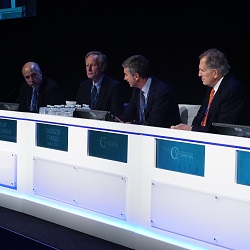
Yesterday, the CX ilegx Interdisciplinary Consensus on Severe Ischaemia explored all stages of managing severe limb ischaemia—looking at diagnosis, diabetic patients, and treatment options. This is in keeping with the ilegx’s goal of reducing the rate of amputations and tissue loss related to ischaemia.
The first session of the day addressed the question of “whether to intervene”. In her talk about assessing peripheral artery disease, Mirjami Laivuori (Helsinki, Poland) commented that the ankle-brachial index (ABI) “was the most important tool” in screening for the disease. She noted that an ABI of <0.9 was associated with an increased risk of cardiovascular disease, but added that the tool was “prone to errors”. “In patients with mediasclerosis of the ankle arteries, the ABI can be falsely high and the measurement is unreliable. Toe pressure can be measured alongside the ABI non-invasively—mediasclerosis is minimal in the digital arteries and, therefore, falsely high results are unusual,” she said.
Looking at patients with established peripheral artery disease, in his presentation “Algorithm of care: how has evidence has changed my current treatment practices”, Fabrizio Fanelli (Rome, Italy) commented that treatment has become “more and more” complicated because of the amount of devices now available. He explained that physicians had to determine the most suitable treatment for a lesion, adding that drug-coated balloons had “great efficacy” for some lesions but were less effective for others (eg. heavily calcified lesions).
Focusing on patients with critical limb ischaemia, Barry Katzen (Miami, USA) noted that there were “patients in whom multiple procedures and technologies fail”. He added: “It was important for operators to understand when a cycle of failure is developing and when, perhaps, amputation may be the best solution for a patient.”
The following session specifically looked at diabetic and critical limb ischaemia patients, and saw Gunnar Tepe (Rosenheim, Germany) review the available evidence for the use of drug-coated balloons in diabetic patients and in women. “Beneficial drug-coated balloon treatment has been demonstrated in these historically challenging subgroups. However, each drug-coated balloon must be evaluated on the merits of its own evidence,” he told CX delegates.
In a subsequent session on managing below-the-knee lesions, Eugenio Stabile (Salerno, Italy) presented data from two registry studies for a next-generation drug-coated balloon (Safepax, Cardionovum) in the superficial femoral artery and in below-the-knee lesions. He commented that, for the superficial femoral artery, data were “comparable with those from other similar registries, even in the presence of more complex clinical and anatomical conditions”. The registry results for Safepax in below-the-knee lesions indicated that the device, Stabile added, “was safe and provided satisfactory efficacy” but further data were needed.
Klaus Amendt (Mannheim, Germany), in a session about stenting, spoke about the LOCOMOTIVE registry. This registry, he said, explored the use of a multiple stent delivery system (VascuFlex Multi-LOC; B Braun) to treat de novo and restenotic lesions. According to Amendt, the first clinical experience—at six months—suggests that the system is safe and effective in patients with peripheral artery occlusive disease in the femoropopliteal arteries.
In the final session of the day, which reviewed the role of bypass grafting, Yann Goueffic (Nantes, France) gave the presentation “Follow-up of patients treated by prosthetic bypass of the lower limb: cost model evaluation”. He said that registry data for the Propaten vascular graft (Gore), in below-the-knee lesions, showed that the graft was associated with a high patency rate at two years but added “type I level clinical evidence is still lacking for below-the-knee Propaten bypasses in critical limb ischaemia patients”.
Throughout the session, there were opportunities for delegates to interact with the speakers about the information they presented. Chairman of the CX Organising Board Roger Greenhalgh (London, UK) chaired three roundtables during the session, entitled: “What we learnt about drug-coated balloons at CX 2017”, “What we learnt on stents at CX 2017”, and “What we learnt of the place of the stent, stent graft and open bypass at CX 2017”.







